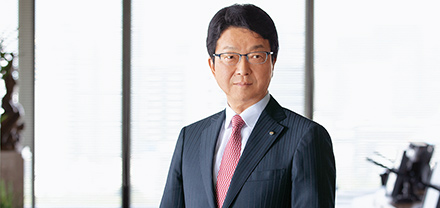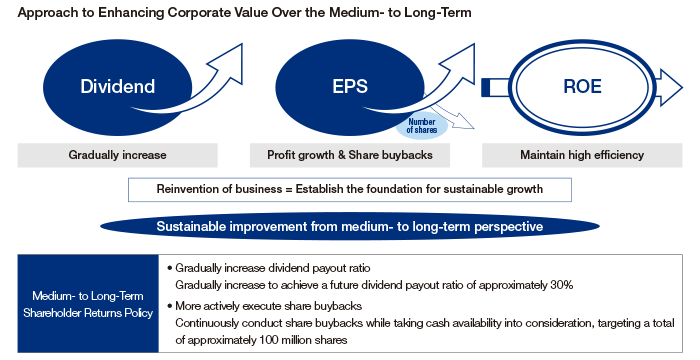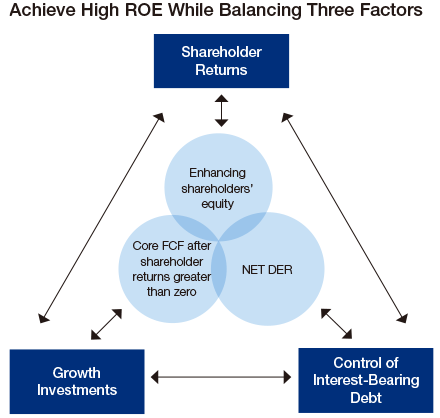CFO Interview

My mission is to consistently and strictly strike a balance between “three factors” regardless of the business environment
Tsuyoshi Hachimura
Member of the Board,
Senior Managing Executive Officer, CFO
Q1 Please provide a general review of the financial and capital strategies in FYE 2019.
A1 We were able to achieve greater results than we had promised the market.
In FYE 2019, the first year of our “Brand-new Deal 2020” medium-term management plan, consolidated net profit reached the ¥500.0-billion level, and we were able to deliver beyond the promises made in our “four commitments,” which I described in this section last year.
First, in terms of “enhancing shareholder returns,” we increased dividends by ¥13 year on year, ¥9 higher than the initial plan, to a record ¥83 per share. Furthermore, based on the Medium- to Long-Term Shareholder Returns Policy announced in October 2018, we conducted share buybacks totaling ¥68.0 billion, and our total shareholder return ratio was around 40% in FYE 2019. In this way, we were able to enhance shareholder returns. In addition, as a result of a shareholder proposal at the FYE 2018 General Meeting of Shareholders concerning the cancellation of treasury stock eventually being voted down despite receiving a certain degree of support, we cancelled 78 million shares.
Next, in terms of “Core Operating Cash Flows,” we posted ¥515.0 billion, a year-on-year increase of ¥55.0 billion. This was a record high for the third consecutive year and exceeded our initial plan of ¥500.0 billion. I believe that this achievement was the result of our continued asset replacement and the steady expansion of core profit accompanying cash flow mainly in the non-resource sector.
In terms of “net debt-to-shareholders’ equity ratio (NET DER),” we improved upon the value of 0.87 times at the end of the previous fiscal year to 0.82 times, right in line with our initial plan. In addition to shareholders’ equity increasing to almost ¥3 trillion due mainly to the accumulation of consolidated net profit, we believe that this improvement was the result of carefully promoting efforts to improve asset efficiency in individual transactions, and practicing appropriate control of interest-bearing debt by accurately examining the impact of the large-scale and numerous conversions into consolidated subsidiaries.
Finally, in terms of ROE, we achieved a result of 17.9%, improving upon the figure of 15.8% at the end of the previous fiscal year, and significantly exceeding our initial target of 15.9%. We were therefore able to maintain the highest ROE among general trading companies for the fifth period in a row, and we believe that we have continued to meet the market’s expectations on the cost of capital.
The results of these consistent financial and capital strategies can be seen in the form of upgrades from credit rating agencies. Beginning with the acquisition of an A credit rating from Moody’s Investors Service in November 2017 for the first time in about 20 years, we subsequently improved our credit ratings from S&P Global Ratings, Rating & Investment Information (R&I), and Japan Credit Rating Agency (JCR) in quick succession by August 2018, thereby successfully acquiring A ratings from all four major credit rating agencies within a year. As a result of this achievement, I believe that, on the ratings front, we have gained domestic and international third-party recognition for our status as a leading general trading company.
Q2 Please inform us about the key points of the Medium- to Long-Term Shareholder Returns Policy announced in October 2018.
A2 The most important points are sustainable EPS growth and enhancement of corporate value.
In my preceding answer, when I explained that we were able to achieve more than we had promised, I was taking into consideration the announcement of the Medium- to Long-Term Shareholder Returns Policy and the demonstration of our approach to shareholders.
In addition to clarifying the two aspects of our approach to shareholder returns in the medium to long term (a period of three to four years from the policy’s announcement) concerning shareholder dividends and share buybacks, we also set forth a policy that focuses on earnings per share (EPS). We will strive to not only reduce the denominator in the EPS calculation formula through share buybacks but also achieve profit growth, the numerator in the formula. By doing so, we aim to further increase EPS and improve corporate value on a sustainable basis. Furthermore, with regard to dividends during the period of “Brand-new Deal 2020,” we have promised a minimum dividend of ¥85 per share for FYE 2020. We have also promised to continue with our progressive dividend policy in FYE 2021.
Accordingly, we will always consider the possibility of increasing dividends while giving consideration to such factors as increases in consolidated net profit, progress of growth investments, and cash flow availability. In addition to the dividend payout ratio, we will focus on the total shareholder return ratio going forward.
Guided by this policy, we have also executed share buybacks ahead of schedule in FYE 2020, having taken into consideration factors including the forecast of cash generation amount and our share price level. It is extremely unfortunate that the valuation of the shares of general trading companies remains low. However, we hope that our stance of swiftly acting on our commitments will be recognized.

Q3 Consolidated net profit reached the ¥500.0 billion level in the first year of “Brand-new Deal 2020.” Are there any changes to the Company’s financial and capital strategies?
A3 There is basically no change.

We will continue to be conscious of striking a balance between three factors (growth investments, shareholder returns, and control of interest-bearing debt) while realizing a high ROE. Furthermore, as a general principle, our policy of maintaining positive Core Free Cash Flows after deducting shareholder returns remains unchanged. However, the following points warrant attention for FYE 2020.
Looking back on our previous medium-term management plan, “Brand-new Deal 2017,” we adopted the policy of building a solid earnings base to generate a ¥400.0 billion level consolidated net profit. In other words, we aimed to raise consolidated net profit from ¥300.0 billion to ¥400.0 billion, and we were able to successfully achieve that goal. Under “Brand-new Deal 2020,” we immediately reached the ¥500.0-billion mark for consolidated net profit in FYE 2019, the first year of the medium-term management plan. However, since core profit was ¥472.0 billion, falling short of the ¥500.0 billion level, we must first build a solid earnings base from which we can generate ¥500.0 billion on a stable basis, and then strive to achieve further growth. Looking at general trading companies as a whole, ¥500.0 billion is a very high profit level and, having reached this mark once, it is important that we maintain it.
To date, we have continued to further strengthen our financial position by drawing upon our strengths principally in the non-resource sector, which is resistant to economic fluctuations, and by enhancing our earning power and cash-generating power. Amid those activities, the management team reflects that since having invested in CITIC, the level of investments conducted has been low from the perspective of realizing further growth. Looking back on the last few years, due to the world economy being generally stable, the number of outstanding investment projects that would be suitable candidates for an M&A has been limited, and acquisition prices remained high. However, going forward, these projects are likely to increase in line with the anticipated fluctuation in market sentiment, which is expected to show signs of both strength and weakness.
Taking into account the projected further increase of Core Operating Cash Flows in FYE 2020 and our backstop of ¥300.0 billion of Core Free Cash Flows after deducting shareholder returns in FYE 2019, in FYE 2020 we intend to conduct growth investments when the time is right, while the Investment Consultative Committee, on which I serve as chairman, will conduct thorough screening, paying close attention to such matters as staying away from investments at their peak in order to refrain from unnecessary accumulation of goodwill. In other words, we maintain our policy to strike a good balance between shareholder returns and growth investments as previously mentioned. Furthermore, since we have made good progress toward strengthening our financial position as demonstrated by our improved credit ratings, we intend to control our interest-bearing debt keeping in mind our current leverage going forward.
Q4 Please tell us your approach to cost of capital when considering growth investments.
A4 I believe that it is an important indicator leading to the enhancement of both capital efficiency and sustainable corporate value.
I mentioned the reason why I am committed to striking a balance between the three factors and realizing a high ROE in my answer to question three, and I believe that it is important that ROE exceeds the cost of capital. In other words, it is important to not only improve capital efficiency but also reduce the cost of capital from the perspective of enhancing sustainable corporate value. Since before the demise of the “commodities super cycle,” we have largely changed our course toward the more stable non-resource sector and made efforts to enhance our earning power and cash-generating power, as well as promoting asset replacement of low-efficiency or peaked-out assets. This is proof that we are incorporating cost of capital into our management decisions. Looking back, we introduced Risk Capital Management in FYE 2000, when management improvements became a matter of urgency, and set the cost of shareholders’ equity at 8%. Since then, the hurdle rates that must be cleared when conducting investments have evolved, and we have now established approximately 40 hurdle rates according to business type (by country) to manage investments meticulously. Furthermore, I believe that it is necessary to thoroughly bear in the mind the impact of non-financial capital on the cost of capital. In particular, the further strengthening of governance, as well as improvements to social and environmental factors regarding ESG, are important debates that will lead to the reduction of obstacles for future growth and of cost of capital. I believe that the initiatives we have taken to promote the diversity of the Board of Directors, such as raising the ratio of outside Directors to more than one-third at all times and transitioning to a monitoring-focused Board of Directors’ structure, as well as increasing the number of female outside Directors from one to two, will contribute to the reduction of the cost of capital and the sustainable enhancement of corporate value.
